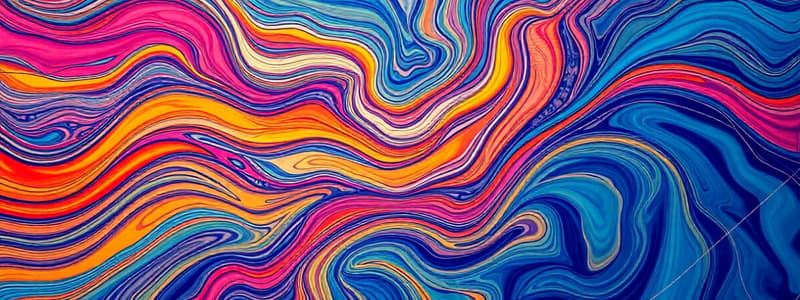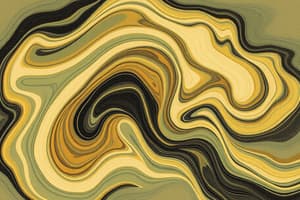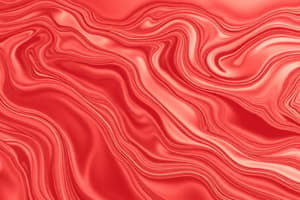Podcast
Questions and Answers
What does kinematics primarily focus on?
What does kinematics primarily focus on?
- The pressure distribution in stationary fluids
- The forces causing motion
- The energy transformations in a fluid
- The motion of particles without considering forces (correct)
Which statement best describes a stream line?
Which statement best describes a stream line?
- An imaginary line indicating the direction of velocity vector (correct)
- A curve traced by a fluid particle during its motion
- A line that connects all particles in a fluid at rest
- A fixed path followed by all fluid particles in steady flow
How is the time taken by a fluid particle to move a distance 'ds' along a stream line expressed?
How is the time taken by a fluid particle to move a distance 'ds' along a stream line expressed?
- t = ds^2/Vs
- t = ds/Vs (correct)
- t = Vs/ds
- t = (dx + dy + dz)/Vs
What delineates a path line in fluid dynamics?
What delineates a path line in fluid dynamics?
In unsteady flow, what happens to fluid particles in relation to stream lines?
In unsteady flow, what happens to fluid particles in relation to stream lines?
What is a streak line in fluid dynamics?
What is a streak line in fluid dynamics?
What defines an instantaneous stream line?
What defines an instantaneous stream line?
Which of the following relationships is correct for a fluid particle moving along a stream line?
Which of the following relationships is correct for a fluid particle moving along a stream line?
What is defined as a boundary surface across which fluid cannot penetrate?
What is defined as a boundary surface across which fluid cannot penetrate?
In which type of flow does the velocity, pressure, and density at a point change with respect to time?
In which type of flow does the velocity, pressure, and density at a point change with respect to time?
Which type of fluid flow is characterized by smooth and parallel movement of fluid particles?
Which type of fluid flow is characterized by smooth and parallel movement of fluid particles?
What does the Reynolds number indicate in fluid flow?
What does the Reynolds number indicate in fluid flow?
What is the defining characteristic of compressible flow?
What is the defining characteristic of compressible flow?
Which type of flow is assumed to be one-dimensional?
Which type of flow is assumed to be one-dimensional?
What is the unit of discharge (Q) for liquids?
What is the unit of discharge (Q) for liquids?
Which flow type does not permit any rotation of fluid particles during flow?
Which flow type does not permit any rotation of fluid particles during flow?
Which property describes steady flow?
Which property describes steady flow?
What describes two-dimensional flow?
What describes two-dimensional flow?
Flashcards
Kinematics
Kinematics
The branch of science dealing with motion without considering the forces causing it.
Streamline
Streamline
An imaginary line showing the direction of velocity in a flow field. No flow crosses it.
Pathline
Pathline
The actual path of a single fluid particle as it moves.
Streakline
Streakline
Signup and view all the flashcards
Steady Flow
Steady Flow
Signup and view all the flashcards
Unsteady Flow
Unsteady Flow
Signup and view all the flashcards
Velocity
Velocity
Signup and view all the flashcards
Differential equation of streamline
Differential equation of streamline
Signup and view all the flashcards
Uniform Flow
Uniform Flow
Signup and view all the flashcards
Laminar Flow
Laminar Flow
Signup and view all the flashcards
Turbulent Flow
Turbulent Flow
Signup and view all the flashcards
Compressible Flow
Compressible Flow
Signup and view all the flashcards
Incompressible Flow
Incompressible Flow
Signup and view all the flashcards
Stream Tube
Stream Tube
Signup and view all the flashcards
Discharge (Q)
Discharge (Q)
Signup and view all the flashcards
Instantaneous Streamline
Instantaneous Streamline
Signup and view all the flashcards
Study Notes
Kinematics of Fluid Flows
- Kinematics studies fluid motion without considering the forces causing it.
- Knowing velocity allows determining pressure distribution and forces on the fluid.
Streamlines
- A streamline is an imaginary line with a tangent representing velocity direction at each point.
- No flow occurs across a streamline.
- The differential equation for a streamline is: dx/u = dy/v = dz/w, where u, v, and w are velocity components.
Path Lines
- A path line is the trajectory of a single fluid particle.
- It connects the positions of a particle over time.
- Streamlines and path lines may differ in unsteady flow.
Streak Lines
- A streak line shows the paths of all fluid particles passing through a fixed point.
- Dye or smoke traces out streak lines.
- In steady flow, streamlines, path lines, and streak lines coincide.
Instantaneous Streamlines
- In time-dependent flow, streamlines change with time.
- An instantaneous streamline represents the position of a streamline at a specific instant.
Stream Tubes
- Streamlines forming a closed curve create a stream tube.
- Fluid cannot cross stream tube boundaries.
- The amount of fluid entering a stream tube equals the amount leaving.
Flow Classifications
- Steady vs. Unsteady:
- Steady flow: Fluid properties (velocity, pressure, density) remain constant with time at a specific point.
- Unsteady flow: Fluid properties change with time at a specific point.
- Uniform vs. Non-uniform:
- Uniform: Velocity stays constant with respect to space (direction).
- Non-uniform: Velocity changes with respect to space.
- Laminar vs. Turbulent:
- Laminar: Fluid particles move in smooth, parallel layers (streamlines).
- Turbulent: Fluid particles move in a chaotic, irregular manner, creating eddies. Reynolds number (VD/v) helps determine flow type.
- Compressible vs. Incompressible:
- Compressible: Fluid density changes with flow.
- Incompressible: Fluid density remains constant. Liquids are typically incompressible.
- Rotational vs. Irrotational:
- Rotational: Fluid particles rotate about their axes as they flow.
- Irrotational: Fluid particles do not rotate.
- One, Two, and Three-Dimensional Flows:
- One-dimensional: Flow parameters vary with one spatial coordinate.
- Two-dimensional: Flow parameters vary with two spatial coordinates.
- Three-dimensional: Flow parameters vary with three spatial coordinates.
Discharge (Rate of Flow)
- Discharge (Q) is the volumetric flow rate per unit time.
- For liquids, units are m³/s or L/s.
- For gases, units are kgf/s or N/s.
Studying That Suits You
Use AI to generate personalized quizzes and flashcards to suit your learning preferences.





